Dishwashing Liquid as an Innovative Flea Control Method
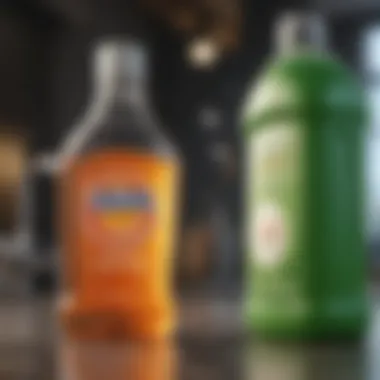
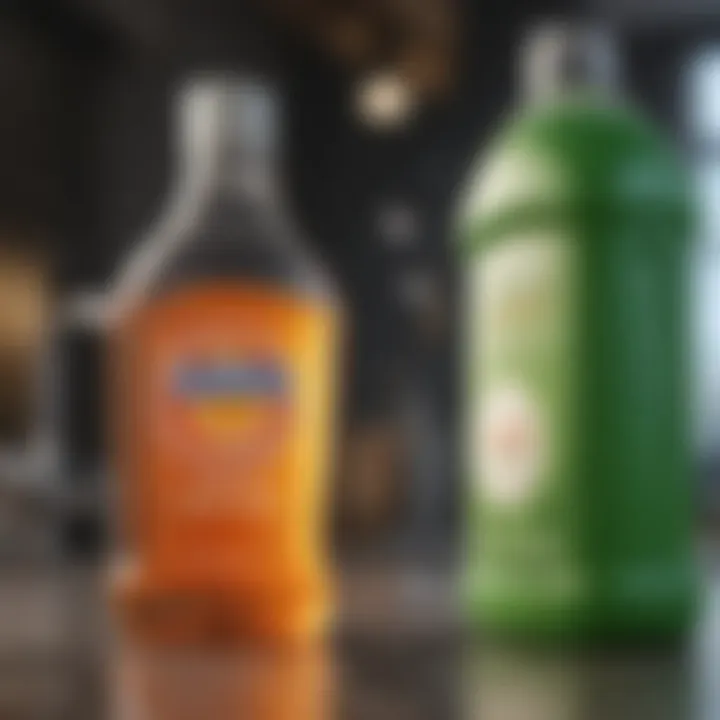
Intro
Flea control is a critical issue for pet owners. Fleas can cause discomfort for pets and pose health risks, including allergic reactions and skin infections. Traditional treatments exist but some pet owners search for alternative methods. One such option is the use of dishwashing liquid. This article unpacks the relevance and efficacy of dishwashing liquid in flea management, examining its effectiveness and comparing it against conventional methods.
Pet Care and Grooming
Importance of Regular Care
Regular pet care is essential in maintaining both the health of pets and a flea-free environment. Grooming serves not only a cosmetic purpose but also aids in the early detection of fleas. An effective grooming routine can prevent infestations before they escalate.
Grooming Techniques by Pet Type
Different pets require distinct grooming techniques. For instance, a short-haired dog may need less frequent brushing than a long-haired cat. It is crucial to choose the right grooming tools to effectively dislodge fleas and dirt. Comb types can vary based on the pet's coat type – fine-toothed combs for cats and medium-toothed for dogs help target fleas more efficiently.
Tools and Products Recommendations
Selecting the right tools is key. Recommended tools include:
- Flea combs: Works well for locating and removing fleas.
- Bathing products: A mild dishwashing liquid may help in removing fleas, but make sure it is safe for pets.
- Brushes: Choose according to the hair type.
Seasonal Care Tips
Seasonal changes can influence flea behavior. During warmer months, fleas are more active. To combat this, regular baths and inspections during spring and summer is advisable. Additionally, maintaining cleanliness in pet bedding and areas frequented by pets can further reduce flea presence.
Health and Nutrition
Understanding Pet Nutrition
Well-balanced nutrition is vital for a pet’s immune system. A healthy pet is better equipped to resist fleas and other parasites. Proper dietary sources contribute to overall health and can help minimize the likelihood of flea infestations.
Common Health Issues by Species
Different species face unique health challenges related to flea infestations. For example, cats may develop flea allergy dermatitis, while dogs might experience anemia from severe infestations. Awareness of these issues is essential for timely intervention.
Preventive Care and Regular Check-Ups
Regular vet visits help ensure the overall health of pets. During check-ups, veterinarians can provide insight on effective flea control methods. This preventive approach is often more efficient than addressing an infestation after it has occurred.
Food and Dietary Advice
Selecting top-quality pet food is crucial. Look for foods with natural ingredients and avoid fillers. Consulting with pet nutritionists can provide tailored advice according to specific needs.
Behavioral Training
Basics of Positive Reinforcement
Training pets is essential. Using positive reinforcement helps in promoting good behavior. This principle can extend to grooming rituals, where rewarding pets for calm behavior can ease the process.
Training Techniques Users Can Apply
Utilizing clear commands and consistency are key. For example, teaching
Understanding Fleas and Their Lifecycles
Fleas are more than just pesky nuisances for pet owners. Understanding them is crucial for effective control and prevention. Fleas thrive in various environments and possess complex life cycles, which can complicate management strategies. Therefore, gaining knowledge of their biology and behavior can assist pet owners in selecting the most effective solutions for pest control. This understanding aids in recognizing the signs of an infestation early, allowing for timely intervention.
Flea Biology and Behavior
Fleas, belonging to the order Siphonaptera, exhibit unique biological characteristics. They are tiny, wingless insects known for their jumping ability. With strong hind legs, they can leap many times their body length. This ability not only helps them in mobility but also in finding hosts for blood meals, which are essential for their reproduction. Fleas depend on the warm-blooded animals for feeding, generally preferring cats and dogs as hosts.
Their anatomy consists of a hard exoskeleton that protects them from physical damage and desiccation. They also possess specialized mouthparts designed for piercing skin and ingesting blood. Fleas are highly adaptable, quickly adjusting to changes in their environment, which makes control efforts more challenging. Understanding flea behavior, such as their feeding and breeding patterns, is essential for developing effective pest management strategies.
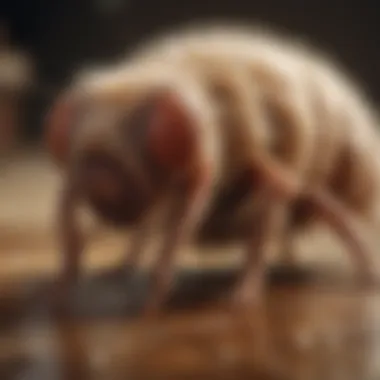
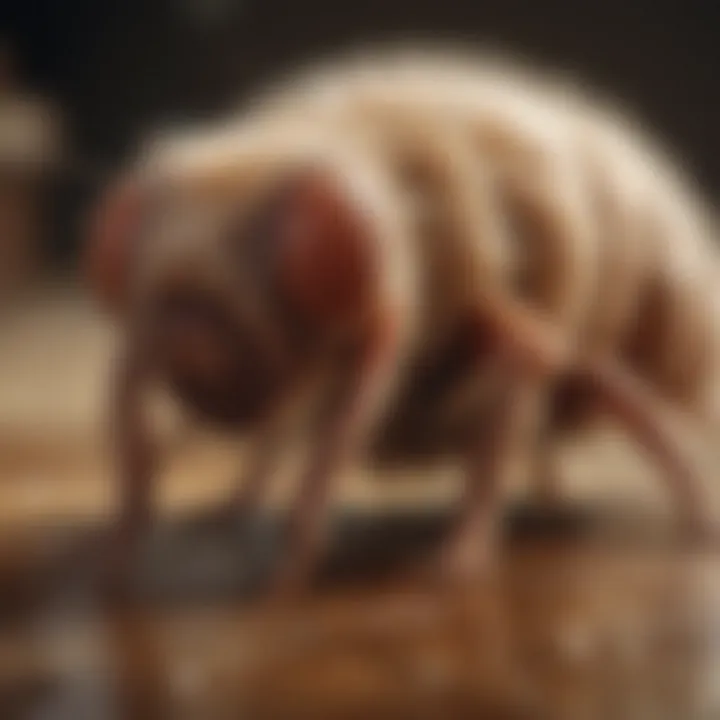
Stages of Flea Development
Flea development occurs through four distinct stages: egg, larva, pupa, and adult. Each stage presents unique challenges for management.
- Egg: Adult fleas lay numerous eggs, roughly 20-30 per day. Eggs can fall off the host and be found in the environment, making them difficult to locate.
- Larva: After a few days, eggs hatch into larvae. These are blind and prefer dark, moist environments where they feed on organic debris, including flea feces.
- Pupa: The larval stage leads to pupa. This stage can remain dormant for extended periods, making them resilient to control measures. Conditions such as heat and vibrations can trigger adult emergence.
- Adult: The final stage is the adult flea. After emerging, they must find a host quickly to feed and reproduce, thus continuing the cycle.
Understanding these stages is vital. Effective control measures must target all stages of the flea life cycle, not just adults. Failure to do so can result in continued infestations.
Common Flea Species Affecting Pets
Several flea species are prevalent among domestic pets. The most common type is the Ctenocephalides felis, or the cat flea, which also infests dogs. Another notable species is Ctenocephalides canis, primarily affecting dogs. They can haunt their environments, laying eggs in carpets, pet bedding, and furniture. Each species has different behaviors and reproductive rates, which impact control strategies.
Identifying the specific flea species affecting pets can aid in the selection of the appropriate management approach. Regular inspections and vigilance are key components in preventing infestations in households with pets.
Understanding fleas is essential for effective prevention and control strategies. Knowledge of their biology, development stages, and common species among pets can lead to better pest management choices.
The Role of Dishwashing Liquid in Pest Control
Dishwashing liquid often serves a primary function in cleaning dishes but its role in pest control, specifically for fleas, has gained attention. This section unpacks the various aspects of why dishwashing liquid has potential as a flea control method.
Its effectiveness largely hinges on its composition and the mechanisms by which it operates against flea infestations. Many pet owners seek alternative methods for flea management due to concerns about chemical treatments. Understanding how dishwashing liquid can fit into pest control strategies provides valuable insights.
Chemical Composition of Dishwashing Liquid
The chemical composition of dishwashing liquid plays a pivotal role in its efficacy against fleas. Primarily, dishwashing liquids are formulated with surfactants, which are compounds that lower the surface tension between two substances, such as oil and water. These surfactants work to break down grease and grime on dishes, but they also have another significant function: they disrupt the protective cuticle of fleas.
Key components of dishwashing liquid usually include:
- Surfactants: These are the primary ingredients and can be classified into anionic, cationic, and nonionic types, each influencing their efficacy differently.
- Preservatives: Ingredients that prevent microbial growth but may offer little value for flea control.
- Fragrances and Colorants: Mostly for appeal, these additives do not contribute to pest control and can be irritating to some pets.
- Additives: Some formulations may include enzymes or other agents aimed at enhancing cleaning performance.
While the precise effects can vary between different brands, the surfactants are the critical players in dismantling flea barriers, ultimately leading to their demise. Understanding this chemical framework is essential for pet owners considering dishwashing liquid as an alternative flea remedy.
How Dishwashing Liquid Disrupts Flea Physiology
Dishwashing liquid impacts flea physiology in several overlapping ways. When applied, the surfactants in the liquid penetrate the fleas' exoskeletons, which are designed to protect them from environmental stresses. This disruption alters the insect’s normal functioning and can lead them to suffocate or become unable to maintain homeostasis.
Mechanisms at play include:
- Surface Tension Reduction: The surfactants reduce the surface tension of water, allowing it to spread more effectively over the flea's body. This facilitates better contact, increasing the potential for the liquid to disrupt the flea.
- Drowning Effect: As the fleas lose their protective barrier, they become more susceptible to drowning. The enhanced spread of water is crucial in this context.
- Dehydration: By penetrating the flea's exoskeleton, dishwashing liquid also compromises its ability to retain moisture. This eventually leads to dehydration and demise.
Fleas, while resilient, rely on their exoskeleton for survival. Dishwashing liquid uniquely targets this vulnerability, making it a noteworthy consideration in alternative pest control strategies.
In summary, the dual focus on the chemical composition of dishwashing liquid and its physiological effects on fleas provides pet owners with significant information. It opens the door for informed decision-making regarding optimal flea management in a manner that is safe and effective.
Evaluating the Effectiveness of Dishwashing Liquid Against Fleas
Evaluating the effectiveness of dishwashing liquid as a tool for flea control is essential. Fleas can cause discomfort to pets and lead to secondary infections. Therefore, pet owners seek practical solutions to combat these parasites. Dishwashing liquid is often on pet owners' radar because of its widespread availability and low cost. It is crucial to analyze its real impact compared to traditional flea treatments.
Dishwashing liquid is a common product found in many households. It serves more than just cleaning dishes. When it's applied as a pest control substance, it may provide some benefits. These benefits include affordability and ease of access. However, understanding its efficacy over standard flea treatments requires examination.
Research brings to light the importance of the right tools in flea management. Evaluating the effectiveness of dishwashing liquid helps pet owners make informed choices while considering the health of their pets.
Comparative Studies of Dishwashing Liquid and Flea Treatments
Several studies have compared the efficacy of dishwashing liquid to traditional flea treatments. Some research suggests that dishwashing liquid can disrupt the flea's ability to move effectively by breaking down their exoskeleton. As a result, it might immobilize or kill fleas in certain situations.
For instance, a study conducted at an animal clinic observed the effects of dishwashing liquid on fleas when used in combination with other methods. The researchers found that although dishwashing liquid has some effectiveness, it didn’t eliminate fleas as completely as topical treatments like Frontline or Advantage. These products have specifically designed formulas targeting fleas directly.
A comprehensive approach might include both dishwashing liquid for immediate relief and traditional treatments for long-lasting effects. This conclusion highlights the need for further research but also a balance in pest management.
User Testimonials and Case Studies
User feedback provides valuable insights into the practical efficiency of dishwashing liquid for flea control. Many pet owners shared their experiences through online forums like Reddit and various social media platforms.
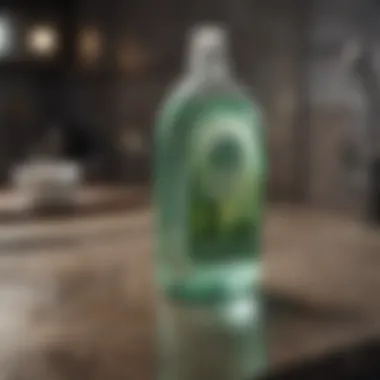
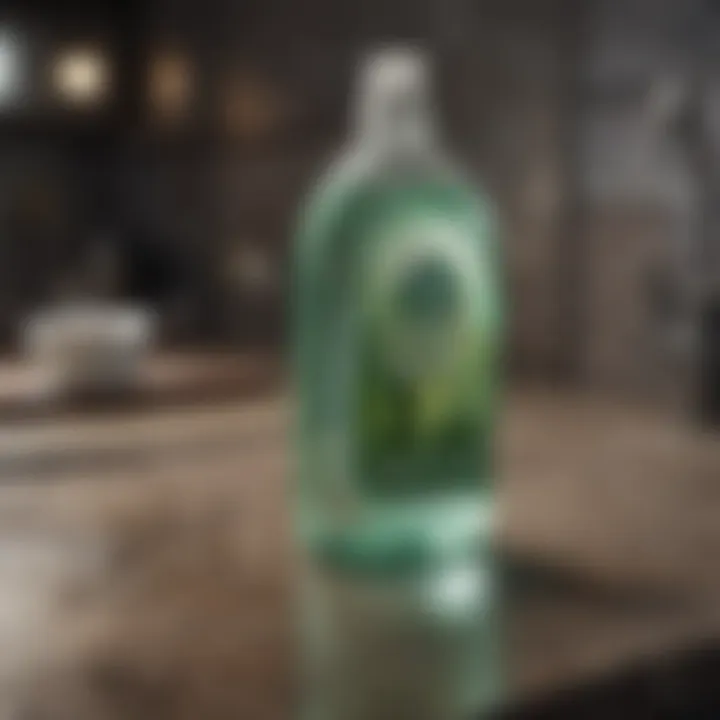
"I used dishwashing liquid along with my usual flea treatment. After using it, I noticed fewer fleas. However, I still followed up with the standard treatments to ensure they were gone completely." – A pet owner from Facebook.
Such testimonials indicate that while dishwashing liquid may offer short-term help, it is often not adequate as a standalone solution.
Additionally, various anecdotes reveal that improper usage can lead to adverse reactions in pets. Thus, it is essential to prioritize pet safety when considering unconventional methods. Pet owners must also monitor any changes in their pets' health after treatment. Proper application and consultation with veterinarians can yield better results and minimize risks.
Practical Application of Dishwashing Liquid for Flea Removal
Dishwashing liquid has gained attention as a potential remedy for flea control due to its accessibility and affordability. Understanding how to apply this substance properly can enhance its efficacy against fleas. This section outlines the preparatory steps, details the application process, and discusses post-application care for pets.
Preparatory Steps Before Application
Before using dishwashing liquid for flea removal, prep work is essential. Here are the key steps:
- Gather Supplies: Collect your dishwashing liquid, a soft sponge or cloth, a bucket of warm water, and towels. This will ensure a smooth application process.
- Choose the Right Product: Select a dishwashing liquid with no added fragrances or harsh chemicals. This reduces the risk of skin irritation for pets.
- Secure Your Environment: Isolate the area where the application will take place. Prevent other pets from entering while you treat one pet. This helps in focusing on the specific animal without distractions.
- Read Labels: Carefully go through the label to ensure that the product is safe for use on pets. Some formulations may contain harmful ingredients.
Proper preparation can make the following steps easier and more effective.
Step-by-Step Application Process
The application process must be conducted with care to ensure effectiveness and safety. Here’s a clear guide:
- Wet the Fur: Lightly soak your pet’s fur with warm water. Avoid getting water into their ears and eyes. This helps the dishwashing liquid to spread evenly.
- Apply Dishwashing Liquid: Use a small amount of dishwashing liquid. Work it into the coat, starting from the neck and moving towards the tail. Thoroughly rub the liquid into the fur, especially in areas where fleas are more likely to be present.
- Create a Lather: Massage the liquid in well to create a lather. This enhances its ability to penetrate the flea's exoskeleton.
- Rinse Thoroughly: After allowing the liquid to sit for a few minutes, rinse your pet completely with warm water. Ensure all traces of the liquid are washed away.
- Dry Your Pet: Use a towel to dry your pet off. Be gentle around sensitive areas, and ensure they're comfortable during this process.
Following these steps ensures effective flea removal while minimizing discomfort for your pet.
Post-Application Care for Pets
After applying dishwashing liquid, there are crucial steps to take for your pet's well-being:
- Monitor for Reactions: Keep an eye on your pet for any adverse reactions, like excessive scratching or redness. If any severe reactions occur, contact a veterinarian immediately.
- Avoid Bathing: Do not bathe your pet again soon after the application unless it's necessary. Give them time to adjust to the treatment.
- Check for Fleas: In the following days, regularly check your pet for flea activity to see if the treatment was effective. You can use a flea comb to help with detection.
- Maintain Flea Control Measures: Ensure you continue with regular flea prevention strategies, such as vacuuming your home frequently and laundering pet bedding, to combat flea reinfestation.
Educating pet owners about practical applications can significantly improve their flea management strategies.
This comprehensive guide serves to equip pet owners with the necessary knowledge for using dishwashing liquid effectively for flea control. Such practical steps can help ensure a flea-free environment for both pets and their owners.
Pros and Cons of Using Dishwashing Liquid
Evaluating the pros and cons of using dishwashing liquid for flea control is essential for pet owners. This multifaceted topic not only sheds light on the practical implications of using this common household item but also frames the larger conversation about effective flea management. Understanding the advantages and disadvantages influences informed decisions for pet care.
Advantages of Dishwashing Liquid in Flea Control
Using dishwashing liquid has several notable advantages in combating flea infestations. Among these benefits are the accessibility and cost-effectiveness of dishwashing liquid, making it a popular choice for many pet owners.
- Chemical Action: Dishwashing liquids like Dawn contain surfactants that can disrupt the waxy exoskeleton of fleas. This can lead to dehydration and eventual death of the fleas.
- Ease of Use: The application process of dishwashing liquid is straightforward. A simple mixture with water can be made for bathing pets, which most owners find convenient.
- Alternative Option: For those wary of chemical treatments, dishwashing liquid offers a less toxic alternative. Many times, pet owners seek ways to manage fleas without jumping straight to commercial pesticides, and this can be a viable solution.
- Quick Results: Some pet owners report immediate effects in reducing flea populations after application, which can be reassuring when dealing with persistent infestations.
“Using dish soap has become an integral part of my flea management routine. It’s accessible and significantly reduces flea numbers.”
Disadvantages and Risks to Consider
Despite its benefits, there are disadvantages and risks associated with using dishwashing liquid for flea control. Pet owners should carefully consider these aspects before deciding on this method.
- Skin Irritation: Dishwashing liquid, while effective, can be harsh on a pet’s skin. Regular use might lead to dryness or irritation, necessitating additional care afterward.
- Not a Complete Solution: Dishwashing liquid cannot eliminate fleas from your home environment. Fleas lay eggs and develop in carpets and bedding, requiring a comprehensive management strategy.
- Variable Effectiveness: The effectiveness of dishwashing liquid may vary based on the flea species and level of infestation. In some cases, it may not provide the desired results.
- Potential Ingestion Risks: Cats, in particular, may lick off residues post-bath. Some dishwashing liquids can contain ingredients that are harmful if ingested, causing potential health hazards.
Alternatives to Dishwashing Liquid for Flea Management
Flea infestation can become a pressing issue for pet owners and their beloved animals. While dishwashing liquid shows potential in this area, it is essential to examine other options available for flea management. Understanding these alternatives offers valuable insights, helping pet owners to make informed decisions regarding their treatment options. Each approach has its unique elements, benefits, and considerations you should be aware of.
Conventional Flea Treatments
Conventional flea treatments encompass a range of products designed specifically for eradicating fleas and preventing their return. Products like Frontline, Advantage, and Revolution are medically formulated to target fleas effectively.
These treatments typically come in several forms, including topical solutions, collars, sprays, and oral medications. Each product has a specific method of application, and it is crucial for pet owners to follow the manufacturer's instructions carefully to ensure effectiveness.


Benefits of conventional treatments include their clinical backing and often comprehensive coverage against multiple parasites. However, some of these products may pose risks of side effects or irritations. Pets with sensitive skin or underlying health conditions should be evaluated before starting any new treatment. Moreover, some of these treatments may contain chemicals that are not ideal for every household environment. Unwanted reactions or allergies are potential concerns, thus demanding careful adherence to usage guidelines.
Key Points on Conventional Treatments:
- Clinical formulations with proven efficacy
- Multi-parasitic action
- Requires veterinary consultation for optimal safety
- Side effects possible in sensitive pets
Natural Remedies for Flea Control
In recent years, natural remedies have gained popularity among pet owners searching for gentler flea control options. Some common natural approaches include neem oil, essential oils like peppermint and lavender, and herbal powders such as diatomaceous earth.
Natural remedies often appeal to those concerned about the potential side effects linked to synthetic treatments. For example, diatomaceous earth works physically by dehydrating the fleas, while certain essential oils can act as deterrents without toxic effects on pet or human health when used appropriately.
However, the efficacy of natural remedies may vary, and they often require more frequent application compared to their conventional counterparts. Some home remedies may not be as effective against severe infestations and can lead to ineffective results without proper usage. That's why it is essential to assess the specifics of each remedy used.
Considerations for Natural Remedies:
- Generally considered safer for sensitive pets
- May not be as potent as conventional options
- Requires frequent reapplication
Many pet owners seek a balanced approach to flea management, weighing both natural and conventional methods for optimal results.
Regulatory and Safety Considerations
Understanding the regulatory and safety aspects of using dishwashing liquid in flea control is crucial for pet owners. This section aims to elucidate key elements like safety evaluations, ingredient regulations, and general household product guidelines that are necessary for making informed decisions. Awareness of such considerations enhances responsible pet ownership and ensures the well-being of both pets and their owners.
Safety of Dishwashing Liquid for Pets
When it comes to the safety of dishwashing liquid for pets, various factors need consideration. Dishwashing liquids are designed primarily for cleaning dishes; hence, their formulations might contain ingredients unsuitable for animals. While many dishwashing liquids utilize surfactants to break down grease and dirt, some of these compounds may irritate a pet's skin or stomach if ingested.
Key Considerations:
- Ingredients: It is vital to check the ingredient label for potentially harmful components, such as phosphates or fragrances, which might be harmful.
- Concentration: Using a highly concentrated dish soap may increase the risk of negative side effects. Always opt for dilution before applying.
- Supervision: Always supervise pets during and after any exposure, monitoring for signs of discomfort or allergic reactions.
Pet owners should be cautious and ideally consult veterinarians before using dishwashing liquid as a flea control method.
Regulatory Guidelines on Household Products
Regulatory guidelines focus on the standards that household product manufacturers are required to meet. Agencies like the Environmental Protection Agency (EPA) and the Food and Drug Administration (FDA) enforce regulations on chemical composition and labeling. While dishwashing liquid is not specifically designed for pest control, it falls under general household products, which must adhere to certain safety measures.
Important Regulations:
- Labeling Requirements: All household cleaners must have clear directions for use, warnings, and ingredient lists. This assists consumers in making educated choices.
- Toxicity Testing: Before a product can be marketed, it often undergoes various tests for toxicity to humans and animals, ensuring a baseline of safety.
- Continuous Monitoring: Regulatory agencies evaluate existing products based on new research. Companies may be required to adjust formulations in response to new safety data.
Ultimately, both pet owners and manufacturers must be vigilant about regulatory standards to maintain a safe environment for all household members. Adhering to these guidelines minimizes risks associated with product use and maximizes safety when dealing with flea control strategies.
Ending: Weighing the Outcomes
The topic of using dishwashing liquid for flea control is important. As pet owners face the challenges of managing flea infestations, understanding the efficacy of various treatments plays a critical role in decision-making. Dishwashing liquid can offer a cost-effective alternative compared to traditional flea treatments. It is vital to evaluate not just the effectiveness but also the safety and the specific context in which dishwashing liquid may be utilized. Each pet may respond differently to interventions, and the potential for skin irritation must be factored in.
One key advantage of dishwashing liquid is its wide availability. Many households already have it on hand. This can lead to quicker action against fleas in emergencies. In contrast, conventional flea treatments often require a trip to a pet store or the veterinarian, which can delay treatment. However, dishwashing liquid does not contain the same active ingredients found in specialized flea medications, which are designed to penetrate the flea's exoskeleton and disrupt their life cycle.
Another consideration is the range of effectiveness. Some users report success, while others find it insufficient on its own. Factors such as severity of the infestation, pet's health, and the specific type of fleas can influence outcomes. Therefore, pet owners should weigh both the convenience and the limitations of this method.
"While dishwashing liquid may serve as a temporary solution, it should not replace established flea treatments as a first line of defense."
In summary, while dishwashing liquid can assist in flea control, it is essential for pet owners to approach this method with a balanced perspective. Understanding its place in the broader context of flea management is crucial for a successful outcome.
Final Thoughts on Dishwashing Liquid as a Flea Treatment
Dishwashing liquid has proven to be an intriguing option for flea control. Many pet owners appreciate its potential benefits and ease of use. The mechanism by which it disrupts flea physiology makes it particularly interesting. When properly applied, it can immobilize fleas, leading to immediate relief. However, this is not a permanent solution. Therefore, it is vital to understand its limitations and incorporate it thoughtfully into a more comprehensive flea control plan.
Furthermore, reliance solely on dishwashing liquid could lead to persistent flea problems. Fleas have a complex life cycle that often requires more aggressive treatment approaches. Recommended methods should include environmental controls, such as vacuuming and washing bedding, along with regular applications of approved flea prevention products.
Recommendations for Pet Owners
Pet owners looking to utilize dishwashing liquid as part of their flea management strategy should consider these recommendations:
- Conduct a Test: Before full application, test a small area of the pet’s skin to check for irritation.
- Monitor Flea Level: Keep observing the effectiveness regularly. If fleas persist, transition to more effective treatments.
- Combine Methods: Use dishwashing liquid in conjunction with established flea treatments for better results.
- Environmental Control: Regular cleaning of pet areas is necessary to reduce flea populations.
- Consult a Vet: Always seek professional advice to understand the best approach for specific cases.
In summary, dishwashing liquid can provide temporary relief from fleas. Nevertheless, it should be part of a more holistic flea management strategy, ensuring long-term effectiveness. Regular evaluations and adjustments will help in keeping pet environments flea-free.















